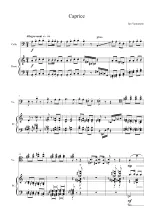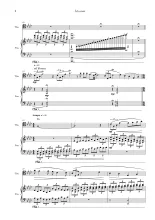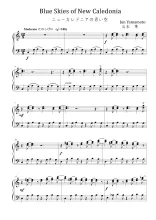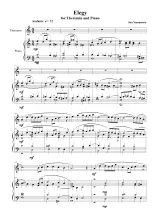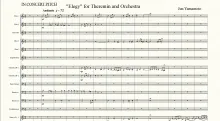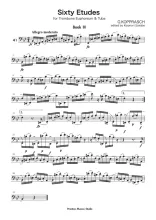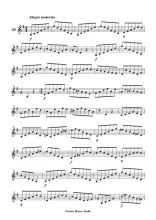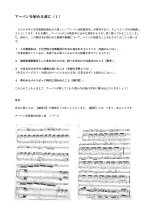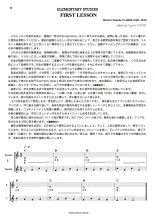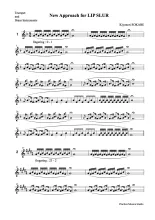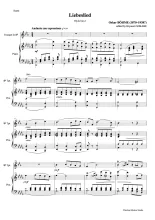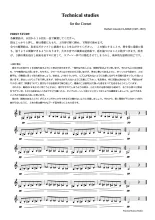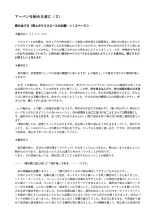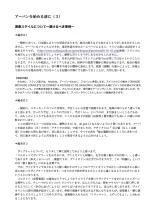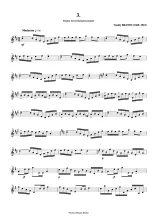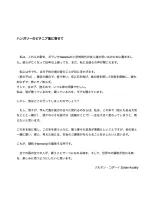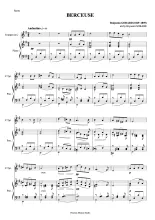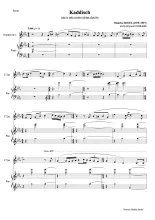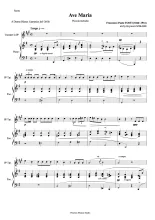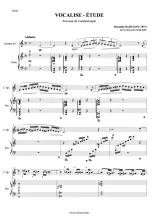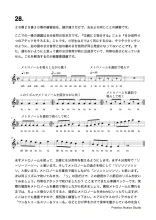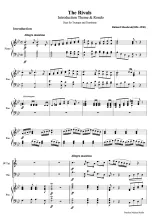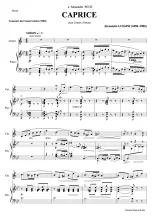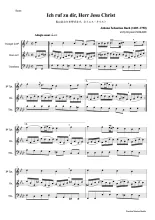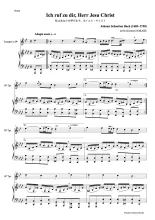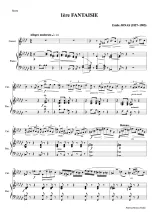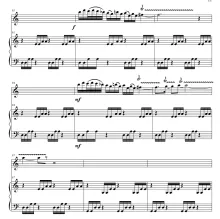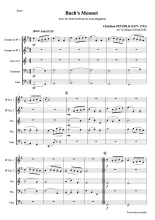New Releases
Our Staff Picks
News
CAPRICE
LUIGINI, Alexandreアレクサンドル・ルイジーニ
20世紀初頭のフランスで、指揮者・ヴァイオリニスト・教育者として超多忙な毎日を送っていたアレクサンドル・ルイジー二が1904年にパリ高等音楽院の試験のために作曲した作品です。余談ですが、祖父がトランペット奏者だったとのこと。この2年後に56歳の若さで急死しています。
Ich ruf zu dir, Herr Jesu Christ
BACH, Johann Sebastian (arr. SOKABE, Kiyonori)ヨハン・ゼバスティアン・バッハ(arr. 曽我部清典)
バッハのオルガン小曲集(Orgelbüchlein)の中でも、最も感動的で好んで聴かれる第41番(BWV639)をトランペット・ホルン・トロンボーンのために編曲しました。ホルンパートはヴィオラ、トロンボーンパートはチェロをイメージすると良いと思います。
Ich ruf zu dir, Herr Jesu Christ
BACH, Johann Sebastian (arr. SOKABE, Kiyonori)ヨハン・ゼバスティアン・バッハ(arr. 曽我部清典)
バッハのオルガン小曲集(Orgelbüchlein)の中でも最も感動的で好んで聴かれる第41番(BWV639)をトランペットとピアノのために編曲しました。ピアノの右手パートはヴィオラ、左手のパートはチェロをイメージすると良いかもしれません。
Ich ruf zu dir, Herr Jesu Christ
BACH, Johann Sebastian (arr. SOKABE, Kiyonori)ヨハン・ゼバスティアン・バッハ(arr. 曽我部清典)
バッハのオルガン小曲集(Orgelbüchlein)の中でも最も感動的で好んで聴かれる第41番(BWV639)をトランペットとピアノのために編曲しました。ピアノの右手パートはヴィオラ、左手のパートはチェロをイメージすると良いかもしれません。
1ère FANTAISIE
JONAS, Émileエミール・ジョナス
19世紀パリ音楽院のソルフェージュ科の教授だったエミール・ジョナスの幻想曲第1番です。作曲の先生らしく所々にちりばめられたハーモニーがとても美しいです。日本ではおそらく未発表作品と思われます。オリジナルはコルネット用の作品ですが、トランペットはもちろんフリューゲルホルンでも演奏できます。
1ère FANTAISIE
JONAS, Émileエミール・ジョナス
19世紀パリ音楽院のソルフェージュ科の教授だったエミール・ジョナスの幻想曲第1番です。作曲の先生らしく所々にちりばめられたハーモニーがとても美しいです。日本ではおそらく未発表作品と思われます。オリジナルはコルネット用の作品ですが、トランペットはもちろんフリューゲルホルンでも演奏できます。
Un Piccolo Divertimento (Flute and Piano)
YAMAMOTO, Jun山本準
The composer had been amazed to listen and come to know the splendid musical capability of Dizi and Yangqin, demonstrated by Mr. Mingjun Wang and Ms. Min Lin in the summer 2017, of course, owing to the virtuosity of the two fabulous musicians. Dizi can run through very fast passages very lightly and precisely, and play slower melodies much expressively. Yangqin is maintaining its traditional characteristics of the instrument and can freely jump around, or expressively play tremolos (which is very much characteristic of the instrument) on the chromatic scale over full 4 octaves. I tried to fully take advantage of those amazing capabilities of the instruments, and make the music as much as delightful for the listeners.
Though it is a short piece with divertimento character, it consists of roughly 5 parts, i.e. Introduction, Exposition, Yangqin Cadenza, Recapitulation, and Development/Coda. It is a kind of a compacted sonata form with some twist. Introduction starts with ad libtum performance of Yangqin and it introduce the basic four-note motif for the entire composition, i.e. “d-fis-c-f”. In Exposition, Dizi plays the rhythmic first subject over the ostinato of 16-note figure by Yangqin. As Dizi is basically a D major-instrument, the major part of Exposition is based on F# Phrygian. The second subject is slower and based on the “d-fis-c-f” motif. Yangqin extends the tonal feeling from D major toward a multi tonal space. Then a short cadenza by Yangqin follows. Capitalizing the instrument’s 12-tone ability, the music develops freely in the 12-tone system. The Recapitulation is based on roughly A Mixolydian and the first subject appears in a variation form in Dizi. The last part is coda but it has in the same time characteristics of Development of the first subject and the basic motif of “d-fis-c-f”.
The composition premiered as a tentative version by O Mei-kun (Dizi) and Guo Min (Yangqin), on March 9, 2018, at “JFC Asian Traditional, Asian Contemporary”, in Tokyo, Japan, and premiered in the full version by Sham Kin-yu Kenneth (Dizi), Kwok Kaying (Yangqin) on May 31, 2018, “Aisan Tradition, Asian Contemporary”, in Hong Kong.
The composer arranged the original score into a version for flute and piano.
王明君氏・林敏氏の笛子と揚琴のデモンストレーションを拝聴して、その表現力の幅広さに驚かされた。笛子は速いパッセージは軽快に、ゆっくりした表現は情感たっぷりに演奏することができ、一方揚琴は、伝統的な響きを残しながらなんと4オクターブにわたる西洋的な半音音階を縦横無尽、融通無碍に演奏することができる。この曲ではそれらの各楽器の能力をできる限り活かし、聴いて楽しい音楽になるように努めたつもりである。
この曲はそのオリジナルが沈健楡(笛子)郭嘉瑩(揚琴)のお二人によって、2018年5月31日(木)日本香港交流音楽会(香港)にて初演された。
本作品はこのオリジナルをフルートとピアノで演奏できるように作曲者が編曲したものである。
Un Piccolo Divertimento (Flute and Piano)
YAMAMOTO, Jun山本準
The composer had been amazed to listen and come to know the splendid musical capability of Dizi and Yangqin, demonstrated by Mr. Mingjun Wang and Ms. Min Lin in the summer 2017, of course, owing to the virtuosity of the two fabulous musicians. Dizi can run through very fast passages very lightly and precisely, and play slower melodies much expressively. Yangqin is maintaining its traditional characteristics of the instrument and can freely jump around, or expressively play tremolos (which is very much characteristic of the instrument) on the chromatic scale over full 4 octaves. I tried to fully take advantage of those amazing capabilities of the instruments, and make the music as much as delightful for the listeners.
Though it is a short piece with divertimento character, it consists of roughly 5 parts, i.e. Introduction, Exposition, Yangqin Cadenza, Recapitulation, and Development/Coda. It is a kind of a compacted sonata form with some twist. Introduction starts with ad libtum performance of Yangqin and it introduce the basic four-note motif for the entire composition, i.e. “d-fis-c-f”. In Exposition, Dizi plays the rhythmic first subject over the ostinato of 16-note figure by Yangqin. As Dizi is basically a D major-instrument, the major part of Exposition is based on F# Phrygian. The second subject is slower and based on the “d-fis-c-f” motif. Yangqin extends the tonal feeling from D major toward a multi tonal space. Then a short cadenza by Yangqin follows. Capitalizing the instrument’s 12-tone ability, the music develops freely in the 12-tone system. The Recapitulation is based on roughly A Mixolydian and the first subject appears in a variation form in Dizi. The last part is coda but it has in the same time characteristics of Development of the first subject and the basic motif of “d-fis-c-f”.
The composition premiered as a tentative version by O Mei-kun (Dizi) and Guo Min (Yangqin), on March 9, 2018, at “JFC Asian Traditional, Asian Contemporary”, in Tokyo, Japan, and premiered in the full version by Sham Kin-yu Kenneth (Dizi), Kwok Kaying (Yangqin) on May 31, 2018, “Aisan Tradition, Asian Contemporary”, in Hong Kong.
The composer arranged the original score into a version for flute and piano.
王明君氏・林敏氏の笛子と揚琴のデモンストレーションを拝聴して、その表現力の幅広さに驚かされた。笛子は速いパッセージは軽快に、ゆっくりした表現は情感たっぷりに演奏することができ、一方揚琴は、伝統的な響きを残しながらなんと4オクターブにわたる西洋的な半音音階を縦横無尽、融通無碍に演奏することができる。この曲ではそれらの各楽器の能力をできる限り活かし、聴いて楽しい音楽になるように努めたつもりである。
この曲はそのオリジナルが沈健楡(笛子)郭嘉瑩(揚琴)のお二人によって、2018年5月31日(木)日本香港交流音楽会(香港)にて初演された。
本作品はこのオリジナルをフルートとピアノで演奏できるように作曲者が編曲したものである。
Liebster Jesu, wir sind hier.
BACH, Johann Sebastian (arr. SOKABE, Kiyonori)ヨハン・ゼバスティアン・バッハ(arr. 曽我部清典)
バッハのあまたあるコラールの中から、27のコラールの18曲目「最愛のイエス、我らここに集いて」です。装飾された旋律を際立たせる、いわゆるパッヘルベル形式で書かれています。旋律の美しさを感じながら、演奏しましょう。
Liebster Jesu, wir sind hier.
BACH, Johann Sebastian (arr. SOKABE, Kiyonori)ヨハン・ゼバスティアン・バッハ(arr. 曽我部清典)
バッハのあまたあるコラールの中から、27のコラールの18曲目「最愛のイエス、我らここに集いて」です。装飾された旋律を際立たせる、いわゆるパッヘルベル形式で書かれています。旋律の美しさを感じながら、演奏しましょう。
Bach's Menuet
PETZOLD, Christian (arr. YAMAZAKI, Shigeru)クリスチャン・ペツォールト(arr. 山崎茂(しげる))
山崎しげるさんの『優しいブラスアンサンブルシリーズ』第7作。無駄がなく演奏に無理のない編曲に仕上がっていますので、小中学生にでも演奏できると思います。この作品は長くバッハの作品と思われていましたが、最近の研究によって、ペツォールトの作品であることが判明しました。
Zefiro torna
MONTEVERDI, Claudio G. A. (arr. SOKABE, Kiyonori)クラウディオ・モンテヴェルディ(arr. 曽我部清典)
" Zefiro torna, e di soavi accenti " by Monteverdi for Brass trio.
モンテヴェルディの「Zefiro torna, e di soavi accenti」を金管のトリオのために編曲しました。トランペット3重奏や、トランペット・ホルン・トロンボーンや、トランペット・ユーフォニアム・テューバでも演奏できるようオプションのパート譜をたくさん用意しました。これから春になろうという季節に、ぜひ演奏してもらいたい作品です。トランペットトリオは、曲の途中でパートをいろいろ入れ替えてやってみるのも良いでしょう。
